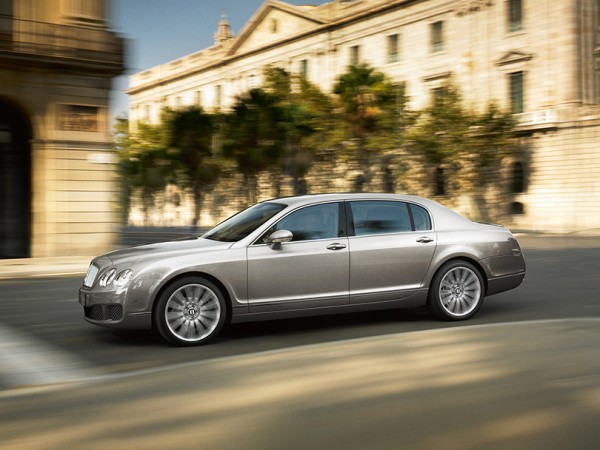The Bentley Flying Spur and Continental GT have an unlikely family connection…
Few brand names
are more recognized than those of cars. Even people who do not possess an irrational affection for the inanimate objects otherwise known as automobiles, will have no problem explaining what kind of cars Lamborghini makes, or Bentley, or even FIAT.
Everybody knows these names because, love them or hate them, cars are everywhere — not least on TV or in movies. Few people are likely to remember which manufacturer won the 1977 Formula One world championship, but if you ask them instead what car Don Johnson drove in Miami Vice they are likely to remember it was a Ferrari.
In more recent times however, things have become a bit more complicated. As car manufacturing became more large scale, and the global economy more open, some brands started to struggle in the ultra-competitive environment. Many went bankrupt, got sold, went bankrupt again, and so on and so forth. In the process, the big sharks of the industry only got bigger as they decimated the guppies. Some brands died altogether, but others were kept alive by their new owners, in an attempt to diversify their lineup and target different types of customers. Few played this game better than Volkswagen.
There is certainly no shortage of cars with a Volkswagen badge on the roads, but once you start counting all the VW cars that are carrying different badges, you end up with a huge percentage. I am certainly not going to pretend that VW sells identical cars with only a different badge and slightly different looks, because the differences go deeper than that. But it does allow them to engineer one platform to serve several different cars, and the same goes for engines. You can find the exact same engines being used whether you are buying a VW, Audi, Seat or Skoda. Nothing wrong with that of course, it makes no sense to develop four similar engines in parallel.
![]()
Modular platforms are a big money saver for car manufacturers
Things get more interesting when you get to the upper end of the luxury market. Let’s look at Bentley, which has been wholly owned by Volkswagen since 1998. Before that, it had been owned by Rolls-Royce all the way back to 1931. For much of that time, Bentley cars were actually little more than re-branded Rolls-Royce models with a slightly more sporty image. They couldn’t make them any less sporty than a Rolls, I suppose, without causing irreparable damage to the laws of physics.
Bentley certainly made some great cars, perhaps not particularly innovative from a technical perspective, but they were utterly British and the fine fellows who drove them wearing plaid trousers to the golf course and back felt right at home in them.
![]()
Bentley Continental R
In my humble opinion, the last proper Bentley was the Continental R, which had such a hilarious amount of horsepower that you could go through a set of rear tires before you got to the end of your driveway. People who owned them generally had long driveways. It was the automotive equivalent of the Queen dyeing her hair purple, but in a dignified way of course. Her Majesty would certainly find a way, as Bentley did.
Seeing a Continental R in the flesh always remained a rare occurrence, which is not something I can say about the first car Bentley made under Volkswagen’s ownership: the Continental GT.
![]()
Bentley Continental GT
There is no nice way of saying this, but the Continental GT is in no small part based on the VW Phaeton. A car which is a lot cheaper, and actually a lot rarer come to think of it, than the Bentley equivalent.
![]()
Volkswagen Phaeton
Euphemistically it is said that these cars share a platform — in practice it means that while you get an absolutely lovely Bentley interior and exterior, many of the mechanical parts doing the actual driving are made in Volkswagen factories, not Bentley and definitely not Rolls-Royce.
That doesn’t make the Bentley a bad car of course, it’s still very fast in a straight line and still isn’t too keen on taking corners quickly — just like the old Continental R. But on some level, it just feels wrong. The Bentley brand name is recognized and revered for its racing history, and for adding spice to the quintessentially British Rolls-Royce. The brochures once boasted that the grille on a Bentley was the only part that made it different from a Rolls.
![]()
«The only mechanical difference was the radiator…»
So, to put the B badge on nothing more than an updated and improved a more luxury version of a large Volkswagen sedan seems contrary to the philosophy Bentley was built on. Cynical people might call it little more than a marketing trick to sell a similar product at a 300% premium. I wouldn’t go that far, but I do believe Bentley customers in the year 2014 are expecting to get a high quality, exclusive and modern product — it is difficult to fit the Volkswagen D1 platform from 2002 into that picture. Possibly for that reason such facts are not mentioned in the brochure. Of course, the brochure is still all about the British heritage and exclusivity. To be fair, the old, ultra-masculine cars never sold anywhere near as well as the newer, more feminine ones do. So it’s hard to argue that the transformation has not been a success, no matter how much it may upset purists.
Plus, Rolls-Royce isn’t quite as British as it once was, either. They were bought by BMW who would have bought Bentley as well had VW not outbid them for it while both brands were up for sale. Fortunately, BMW isn’t pushing the technology overlap quite as far, with engines being the biggest technological contribution. Rolls is still almost as British as a Mini, then, if we keep in mind the fact that BMW owns the Mini brand as well. On the upside, making British cars German has had the side effect that they are now faster and don’t break down as much, which is a plus I suppose.
Perhaps the worst sins were perpetrated by Ford however, during the years when they owned both the Aston Martin and Volvo brands. The result of Ford’s efficient resource management was a new Aston Martin which still looked and sounded fabulous, but came with a Volvo ignition key and a Volvo GPS navigation. One of their other brands, Jaguar, began selling the X-type which used the same platform as the Ford Mondeo. At least the accountants did authorize a little extra money to change the logos here and there.
![]()
Oops…
Fortunately, all these brands escaped from Ford ownership before it was too late. Aston Martin was bought by a private consortium of investors in 2007, Jaguar went to Tata Motors together with Land Rover and Volvo is now owned by Geely. So far, all of them are enjoying much more independence in the Indian and Chinese companies than they ever had under American ownership.
Others were not so lucky.
General Motors pretty much ruined Saab single-handedly by reducing them to selling slightly unusual looking Opels. As heavy losses mounted year after year, it never occurred to them that perhaps their customers were not complete idiots. Instead, each bad year only drove them to cut more Saab workers, as they kept selling the same re-badged, outdated cars with a few cosmetic updates every now and then. What they clearly failed to understand was that, particularly for niche brands, people want the real thing. Not just the badge.
The same car, by another name, definitely does not smell as sweet.
![]()
Back to the glory days: Saab Sonett

Last article
Mechanisms with Jan Coomans: Yes, you can (afford one)
Today I’m starting a one man campaign
to make the roads a little less dull. And, while I’m at it, encourage those with a love for driving to be a little more bold in choosing their next car. Life’s too short — and the world’s oil supply too finite — to waste it by driving only sensible automobiles. Let’s get rid of common sense for once and for all and go nuts.
Let’s take some of the most common cars I see in Moscow these days. How about a Mazda 6? Great car for the money really. It’s a very well built, reliable car which will happily and comfortably get you to your destination for many years to come. Of course it’s not particularly stunning to look at or exciting to drive, but then again we weren’t exactly expecting it to be a Porsche 911.
As it turns out, there is a fairly simple solution to this problem: buy a Porsche 911 instead. Ta-daa. Simplicity, I love it. At this point, I know you might feel a tendency to raise your hand and ask «but what about the price?». Excellent question, glad you asked. Turns out you can buy a Porsche 911 for the same money as you’d spend on a new Mazda 6. Sure, it’s going to be a few years older, but thankfully Porsche has the laziest design department in the world so hardly anyone will notice…











